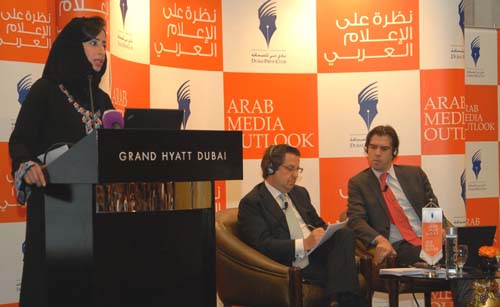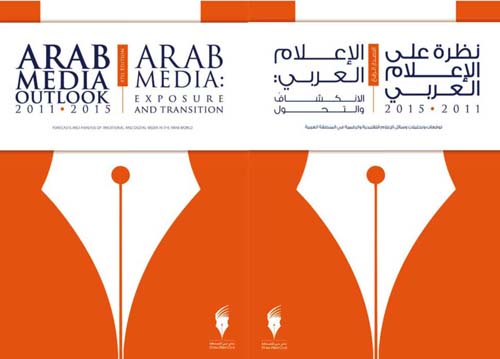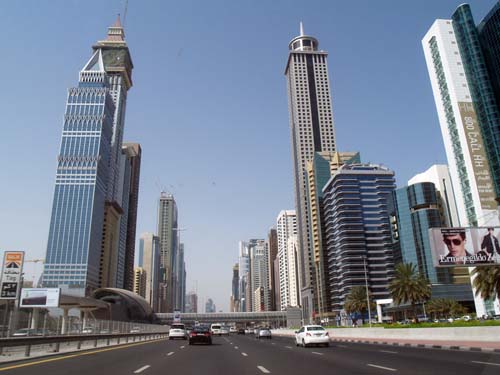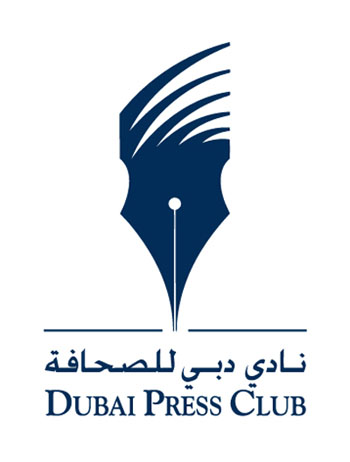It's become an annual must read to take the pulse of where they are, but this year's edition of "Arab Media Outlook 2011-2015" (AMO) goes further to shed more light on what's to come amid a sea of uncertainty.
"The current edition of the report is set against a period of great turbulence across the region," Maryam Bin Fahad, the Dubai Press Club's (DPC) executive director, wrote in the foreword. "The combination of a weak global economic environment and political instability across several regional markets makes it more challenging to assess the impact on the media landscape in the near term."
 DPC Executive Director Maryam Bin Fahad launching 4th AMO findings (Courtesy of Dubai Press Club)
DPC Executive Director Maryam Bin Fahad launching 4th AMO findings (Courtesy of Dubai Press Club)
She added that in several markets directly affected by political uprisings, the media industry's structure was being overhauled, with a significant break from the past.
But the pace of media reform in these markets was gradual, she noted, as the medium-term agenda seems to focus on pressing economic and political issues.
That's to the consternation of impatient press freedom advocates who have fought long and hard in countries like Tunisia, Egypt, Libya and Syria, and have been undergoing revolts to change regimes and systems that have affected media performance for decades.
"On a positive note, despite the immediate impact on advertising revenues, the recent events have had a positive impact on Arab media raising the bar for the quality of news reporting, accelerating the engagement with digital platforms and placing the region firmly on the strategic map of global media houses," Bin Fahad added.
Specifically, the report points to markets directly affected by the regional uprisings where the media show encouraging signs of liberalization in the print and broadcast sectors.
"Close to 65 percent of those interviewed affirmed a positive outlook for the industry in 2012, reflecting their confidence in the ability of the industry to recover from the turmoil of the last couple of years," up from 59 percent in last year's figures, the report said.
 Arab Media Outlook (Courtesy of Dubai Press Club)
Arab Media Outlook (Courtesy of Dubai Press Club)
Also on the projected upswing is advertising spend, which in 2012 is shifting from legacy media to digital and mobile platforms that are becoming ubiquitous across the Arab world.
That should come as good news to media stakeholders who've been on a roller coaster ride in recent years and where in certain Arab countries revenues have taken a beating due to drops in print circulations and a growing youth population with a preference for mobile devices to receive their daily doses of news and entertainment.
"The Millennials are now driving the consumption of and engagement with content via multiple digital tools including social networking platforms, mobile applications, online videos, etc.," according to the AMO. "In the Arab region, the youth have embraced new media as a tool to reach societal and lifestyle ambitions."
Dubai, where the survey was released, is a good example of a country that was negatively affected by the financial crisis but has managed to resume its dynamic activity as a hub for media and business in the Arab Gulf region.
 Dubai always on the move (Abu-Fadil)
Dubai always on the move (Abu-Fadil)
In a segment on print media, the report acknowledged that newspapers had seen the slowest growth in the last five years, although circulation remained "more resilient than in most mature markets."
Arab revolts have also spawned new print outlets as controls loosened in markets previously gripped by state-run media that echoed the official government line.
For their part, magazines also got a boost, the report indicated, with the emergence of new titles in 2010-11 and some growth in circulation.
Women's magazines dominated the landscape with 75 percent of total circulation -- a boon for publishers eyeing circulation and monetization of their products.
TV was another constant in markets like Egypt and Saudi Arabia. Free-to-air satellite channels are more popular in the Arab region than elsewhere in the world, according to the AMO.
"Only a few markets in the region have cable, such as Bahrain, Kuwait, Lebanon, Qatar and the UAE, and it is witnessing a declining trend in terms of overall penetration," it said.
As with print, new broadcast outlets have mushroomed thanks to political upheaval in the region and countries whose dictators had kept a chokehold on radio and TV channels.
"A common thread which runs across many of the new channels is their use of social media to extend reach and increase penetration amongst the Egyptian youth who were averse to traditional news media affiliated to the government," is an example cited by the AMO.
Another interesting trend is the expansion of Arab broadcasters' satellite footprint overseas to reach even larger audiences across multiple platforms.
Not surprising is the rapid growth of online and mobile space in the Arab world, the AMO said, with political uprisings boosting the use of social media and time spent communicating in cyberspace.
The AMO underlined the importance of developing local media content and covered areas that had not been touched upon in previous reports: movies, sports and music - key vehicles of globalization.
Moreover, "monetization models are also evolving in line with other markets and we see the emergence of advertising and freemium based models, particularly in the online gaming space," it revealed.
The AMO's 4th edition covered 17 Arab countries and research was conducted by the firm Deloitte for the Dubai Press Club. It widened its geographic spread to include Iraq and Libya, both of which saw dynamic changes in the media in the past year.
 DPC Logo (Courtesy DPC)
DPC Logo (Courtesy DPC)
At the launch, the DPC announced the availability of a digital copy as part of a new iPad and iPhone application developed in the United Arab Emriates.
The 252-page English version and 125-page Arabic edition can be downloaded as PDFs by filling out online forms.
The report, to which Media Unlimited contributed, is also being distributed in hard copy during the DPC's 11th Arab Media Forum May 8-9.
